If a load is connected to an AC power source, and the current wave on it is shifted from the voltage wave of the power source, for some periods of time the instantaneous real power (Vinst x Iinst) will give a negative instantaneous power value, due the voltage value be positive and the current value be negative at the same instant, or vice versa. How this "negative power" affect the Wh real power consumption measurement? How it accounts in cumulative energy measurement?
2 Answers
How this "negative power" affect the Wh real power consumption measurement? How it accounts in cumulative energy measurement?
Here are a few waveforms to consider: -
The power waveform is in red and, it is the average value of this waveform that indicates true power consumption. If the instantaneous power goes negative then it just reduces the average power. At 90 ° phase shift between voltage and current, the average power is zero because positive parts exactly cancel negative parts.
- 434,556
- 28
- 351
- 777
-
Thanks. My doubt: I know when the average power is positive it does increase the value of Wh consumption accumulator... but when the average power is negative? It does decrease or also increase the value of Wh consumption accumulator? – abomin3v3l Dec 31 '20 at 12:08
-
1When average power is negative then you are returning power from your load to your supply such as in a solar farm where it is putting power onto the grid. Or, as in a motor that turns into a generator and returns energy back to the source. For most normal loads, it can never happen @abomin3v3l – Andy aka Dec 31 '20 at 12:11
-
Thanks, understood. So in most cases the average power will be positive? And will only be negative due to a very bad power factor? (which would lead to a penalty in a industry)... And anyway, when average power be negative it will decrease the Wh consumption accumulator because the load is giving power back to the source at that period of measurement? – abomin3v3l Dec 31 '20 at 12:23
-
1A very bad power factor occurs when the load is purely capacitive or inductive and the average power is then 0 because PF = 0. Low PF *can* mean a penalty. If Wh is negative AND your energy meter is capable of running in reverse AND you have the right sort of agreement with your energy provider means your bill can reduce. – Andy aka Dec 31 '20 at 12:33
-
Thanks. Do you know if I need to have zero cross detector of voltage to measure the consumption in Wh and VAh of a phase? I'm thinking of sample instantaneous voltage and current at around 200K samples during ONE second (200K for each one, sampling both at the same instant), to be able to (from them) extract the average RMS power of one second (VAh accumulator) and average power of one second (Wh accumulator), so there will be 3600x [W/VA during one second]/3600 to each accumulator during 1 hour. Do you think thats ok? – abomin3v3l Dec 31 '20 at 12:50
-
Resuming: I would like to know if by just sampling the instataneous voltage and current of a phase (at the same time), if I could extract the W and VA values from them, and from this extract the power factor (W/VA), being all the measurements over 1 second period, adding the values of 1 second measurements to the accumulators/3600... – abomin3v3l Dec 31 '20 at 13:00
-
1@abomin3v3l [this should answer your question](https://electronics.stackexchange.com/questions/202667/whats-the-most-economical-way-to-digitally-measure-240v-mains-voltage-current/202690#202690). And also [this one](https://electronics.stackexchange.com/questions/82188/how-is-the-power-factor-part-involved-in-wattmeter-reading/82206#82206). And [also this one](https://electronics.stackexchange.com/questions/76213/how-to-sense-the-zero-crossing-of-current). – Andy aka Dec 31 '20 at 13:13
-
Ok, Actually my goal is only to make a simple wattmeter, that only read the average of W=VxI. Having the average W value over 1 second, I can sum it /3600 to the Wh accumulator, I think... Wh is what is charged by the electricity provider, and my final goal is to know the value in money charged for the operation of a phase which supplies power to loads. – abomin3v3l Dec 31 '20 at 13:45
-
Please, am I wrong with my idea of the last comment? – abomin3v3l Dec 31 '20 at 13:51
-
1Sum each 1 second average and divide by 3600 gives watt hours. – Andy aka Dec 31 '20 at 15:04
How this "negative power" affect the Wh real power consumption measurement? How it accounts in cumulative energy measurement?
The true energy delivered is defined as the time integral of the instantaneous product of the voltage and the current.
How well any particular measuring device measures that, rather than the VA, or something else, depends on how well it has been implemented.
In the old-fashioned spinning disc meter, the disc is driven by a special motor that forms the VI product to generate the torque. The disc is dynamically braked, so speed is proportional to torque. The total angle it turns then forms the time integral. This type of meter records the real power very well, to within its calibration accuracy and friction.
In a full-price modern digital meter, ADCs read instantaneous voltage and current, and the product is summed. This also reads very accurately, subject to all the significant waveform harmonics falling inside the digitisation bandwidth of the ADCs, or to put it another way, the ADCs being fast enough to capture all the significant waveform dynamics.
There are lower cost ways that digital meters may attempt to read true power. One type reads the current waveform, but only measures the phase of the voltage waveform, assuming its amplitude to be nominal, to compute a power factor due to the phase shift between the two waveforms. Other types sacrifice bandwidth for slower ADCs, so miss some high frequency dynamics.
- 158,152
- 3
- 173
- 387

